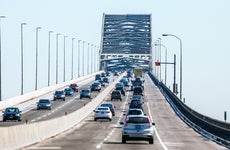Car insurance for high-risk drivers in New Jersey

The Bankrate promise
At Bankrate, we strive to help you make smarter financial decisions. To help readers understand how insurance affects their finances, we have licensed insurance professionals on staff who have spent a combined 47 years in the auto, home and life insurance industries. While we adhere to strict , this post may contain references to products from our partners. Here's an explanation of . Our content is backed by Coverage.com, LLC, a licensed entity (NPN: 19966249). For more information, please see our .
Certain driving-related incidents like drunk driving, speeding or causing a serious accident may cause insurance companies to label some drivers as “high-risk.” If this happens, drivers could pay significantly higher auto insurance premiums or become ineligible for standard car insurance policies. If you’re looking for high-risk car insurance in New Jersey, Bankrate is here to offer potential solutions.
Rates for high-risk car insurance in New Jersey
Rates for high-risk auto insurance in New Jersey can vary by insurer and driver-specific factors. While age is often considered, driving record and claims history also affect rates. Auto insurance companies will factor in driving infractions like speeding ticket convictions, at-fault accidents and DUI convictions when calculating insurance premiums. Teen drivers are also typically considered high-risk due to their lack of experience on the road.
Below, Bankrate showcases how different incidents impact auto insurance rates across companies, based on average premium data from Quadrant Information Services.
Rates after a speeding ticket
A high-risk driver in New Jersey can expect their insurance rates to increase, although the amount will vary by company. Drivers can also face fines between $85 to $260 depending on how much in excess of the speed limit the driver was traveling and where the infraction takes place. Repeat offenders could be jailed, have their vehicle impounded and have their license suspended or revoked. Though not everyone will need high-risk auto insurance after one speeding ticket on their motor vehicle record, repeat offenders may find limited insurance options and need to resort to high-risk insurance coverage.
The table below shows the average yearly rate for full coverage before and after a speeding ticket conviction in New Jersey, including the percentage increase, by company. NJM, Progressive and Travelers are some of the cheapest auto insurance providers in New Jersey for high-risk drivers, on average.
New Jersey average annual full coverage premium
| Car insurance company | Rate before a speeding ticket conviction | Rate after a speeding ticket conviction | % increase |
|---|---|---|---|
| NJM | $1,229 | $1,353 | 11% |
| Progressive | $1,198 | $1,398 | 17% |
| Travelers | $1,385 | $1,725 | 24% |
| Amica | $1,642 | $1,986 | 21% |
| Allstate | $1,837 | $2,392 | 30% |
Rates after an at-fault accident
An at-fault collision is when a driver is responsible for causing personal injury or property damage to another party’s property, or one that results in injuries or damage to their own passengers and vehicle. After an at-fault collision, a high-risk driver label is possible, which can increase insurance premiums. It may also lead to the loss of any safe driver discounts currently on a policy. Subsequent at-fault collisions may result in drivers needing to purchase high-risk car insurance in New Jersey if their current insurer or other companies deem them too risky to insure with a standard policy.
Compare the rates below for average annual premiums before and after an at-fault collision.
New Jersey average annual full coverage premium
| Car insurance company | Rate before an at-fault accident | Rate after an at-fault accident | % increase |
|---|---|---|---|
| Palisades | $931 | $992 | 7% |
| Selective | $1,131 | $1,217 | 8% |
| Progressive | $1,198 | $1,654 | 38% |
| Geico | $1,348 | $1,800 | 34% |
| Travelers | $1,385 | $2,113 | 53% |
Rates after a DUI
A DUI is one of the most serious offenses that can lead to the high-risk driver label. The table below shows before and after average annual rates, with a minimum increase of 10 percent from NJM after a DUI conviction is factored in. If a driver’s license is suspended under New Jersey law after a DUI, they may only be eligible for high-risk auto insurance.
New Jersey average annual full coverage premium
| Car insurance company | Rate before a DUI conviction | Rate after a DUI conviction | % increase |
|---|---|---|---|
| Progressive | $1,198 | $1,327 | 11% |
| NJM | $1,229 | $1,353 | 10% |
| Palisades | $931 | $1,534 | 65% |
| Selective | $1,131 | $1,762 | 56% |
| Geico | $1,348 | $2,360 | 75% |
High-risk drivers may also have to file an SR-22 to prove they have adequate New Jersey car insurance, as their existing carrier may decide not to renew their policy after a DUI conviction. Subsequent convictions could further limit the chances of qualifying for standard auto insurance, resulting in the need for high-risk insurance.
Rates for teen drivers
Even with a clean driving record, most insurance companies consider teen drivers as high risk until they gain enough years of experience behind the wheel. As teens get older and continue to practice safe driving habits, rates usually decrease, although there is no guarantee of lower rates. The table below shows the average annual cost of car insurance with and without a 16-year-old driver included on the policy.
Average annual full coverage premiums
| Car insurance company | Rate without a 16-year-old insured | Rate with a 16-year-old insured | % increase |
|---|---|---|---|
| Progressive | $1,198 | $2,194 | 83% |
| NJM | $1,229 | $2,351 | 91% |
| Palisades | $931 | $2,541 | 173% |
| State Farm | $1,481 | $2,942 | 99% |
| Geico | $1,348 | $2,978 | 121% |
*Rate reflects the total average annual premium for a 16-year-old driver added to their married parents’ policy.
Teens are usually listed as drivers on their parents’ policy. However, that could change if they become a high-risk driver with a speeding ticket, at-fault accident or DUI on their record. If that happens, they may not be renewed and have to pursue high-risk car insurance elsewhere.
What makes you high risk for auto insurance?
A high-risk driver is someone that a car insurance company may designate as more likely to file costly claims. Some behaviors that may flag you as high risk include speeding, drinking and driving or driving distracted, such as texting while driving.
Bankrate’s high-risk driver profile accounts for policyholders who had a lapse in coverage in the past, teen drivers and those who have had one speeding ticket conviction, at-fault accident or DUI conviction on their record.
How to lower your rate if you are a high-risk driver
Insurance rates may remain high as long as the points still show on your driving record. In the case of a DUI, expect to pay higher rates for at least 10 years. To offset some of the costs associated with high-risk driving, consider the following tactics:
- Attend traffic school after receiving a ticket to wipe out points before they are added to your motor vehicle record.
- Shop around and switch car insurance providers if another insurer is able to offer you a better rate.
- Ask for discounts based on your unique profile, such as those for students, military or corporate affiliation, or for having purchased a newer car.
- Adjust your deductible; assuming a greater degree of financial responsibility for future claims can reduce your premiums.
- Compare car insurance quotes each year before your coverage ends to ensure you are still getting the best price.
- Look for a carrier that offers accident forgiveness. While this will not lower rates following a recent incident, you may save yourself from increased rates in the future should one new at-fault accident occur. Limitations may apply. Some providers that offer accident forgiveness are:
- Geico
- Nationwide
- Progressive
- State Farm
- USAA
Frequently asked questions
-
-
New Jersey requires all drivers to carry a minimum amount of liability car insurance coverage. However, starting in 2023, this minimum amount has been increased. New Jersey drivers are now required to carry at least $25,000 in bodily injury liability per person, $50,000 in bodily injury per accident and $25,000 in property damage liability per accident. Personal injury protection will remain the same as before at $15,000, but uninsured and underinsured coverage will need to match the liability limits listed above.
-
A DUI conviction may remain on your record for 10 years or more in New Jersey. If your car insurance rates increase sharply, you may want to shop around to find a cheaper carrier for coverage over the next few years.
-
If you are a high-risk driver in New Jersey, you can likely still find insurance coverage from a number of local and regional carriers. Shop around and compare quotes to find insurance that meets your needs and fits your budget. According to Bankrate’s research, it may be worth looking into NJM, Palisades and Progressive in the wake of a ticket, accident or DUI. While you can expect to pay more for your monthly premium than a driver who does not have any marks on their record, there is likely coverage available that fits your needs.
-
Methodology
Bankrate utilizes Quadrant Information Services to analyze 2023 rates for ZIP codes and carriers in all 50 states and Washington, D.C. Rates are weighted based on the population density in each geographic region. Quoted rates are based on a 40-year-old male and female driver with a clean driving record, good credit and the following full coverage limits:
- $100,000 bodily injury liability per person
- $300,000 bodily injury liability per accident
- $50,000 property damage liability per accident
- $100,000 uninsured motorist bodily injury per person
- $300,000 uninsured motorist bodily injury per accident
- $500 collision deductible
- $500 comprehensive deductible
To determine minimum coverage limits, Bankrate used minimum coverage that meets each state’s requirements. Our base profile drivers own a 2021 Toyota Camry, commute five days a week and drive 12,000 miles annually.
These are sample rates and should only be used for comparative purposes.
Incidents: Rates were calculated by evaluating our base profile with the following incidents applied: clean record (base), at-fault accident, single speeding ticket, single DUI conviction and lapse in coverage.
Age: Rates were calculated by evaluating our base profile with the ages 18-60 (base: 40 years) applied. Depending on age, drivers may be a renter or homeowner. Age is not a contributing rating factor in Hawaii and Massachusetts due to state regulations.
Teens: Rates were determined by adding a 16- or 17-year-old teen to their 40-year-old married parents’ policy. The rates displayed reflect the total cost of a driver this age added to their parents’ policy.
Related Articles


Updated New Jersey car insurance requirements increased premiums for more than one million drivers

